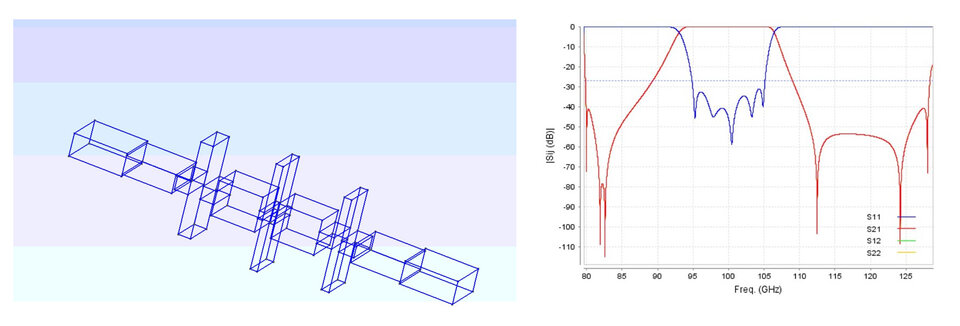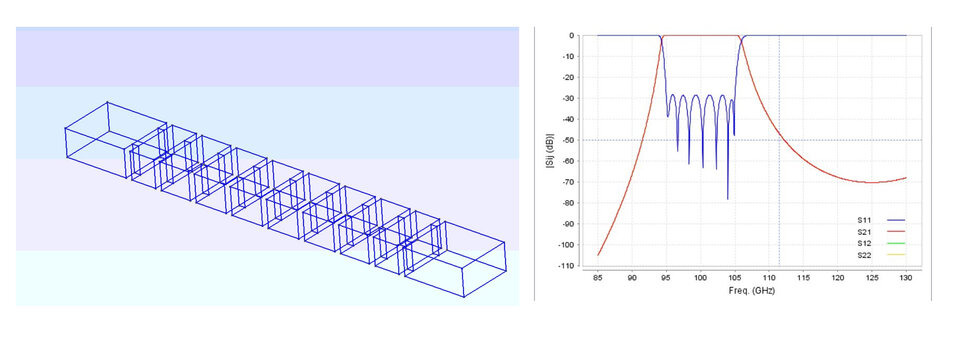Stepped-impedance waveguide filters with multiple-transmission zeros
| 724 - Abstract: |
| A novel band-pass filter (BPF) has been developed to meet stringent specifications in high-frequency bands (for telecommunications or Earth observation applications) with multiple transmission zeros and with a dramatic improvement in the manufacturing yield, which allows the fabrication of the novel filters with low-cost manufacturing techniques (conventional milling or additive manufacturing). ESA is looking for partners who would be interested implementing this invention by getting a license. |
Description:
Recently, the space industry has focused in the exploration of the Q/V/W bands for future commercial telecommunication programs. These architectures use waveguide band-pass filters (BPFs) to remove unwanted spurious coming from the transmission of the payload, other payloads embarked in the same platform or in-ground transmitters.
Classical solutions for waveguide BPFs in Q/V/W-bands use the traditional concept of coupled resonant cavities. However, the accuracy of the usual manufacturing tools (e.g. the standard computer controlled milling) becomes more significant, due to the reduced physical dimensions of these filters at such high frequencies. This causes imprecise fabrications, which lead, to time-consuming, expensive manufacturing processes and additional ohmic losses. For frequencies beyond Q-band, tuning becomes impossible due to the size of the waveguides. Additionally, filter structures based on resonant cavities tend to suffer for imperfections in the clamshell manufacturing due to the high currents and imperfections in the flanges.
The basic idea of the invention is to use a stepped-impedance (non-resonant) structure to obtain the BPF filtering performance and, after that, include the transmission zeros by adding resonant structures. In this case, as the nature of both structures is completely different, they are not affected by themselves. Consequently, the combination of the non-resonant implementation for BPF together with resonant transmission zeros to improve the rejection makes the novel filters less sensitive to manufacturing tolerances. This is particularly attractive for high frequency parts where tuning screws cannot be used. Moreover, the desired passband and the transmission zeros are independently designed and, eventually, a very short optimization is required when assemble the different sections afterwards. It is worth to remark that the number of transmission zeros can be increased without impacting exponentially the design/tuning difficulty.
The invention can be applicable to different structures with different order (stepped-impedance sections) and different number of transmission zeros (stopband elements) and at different frequencies with excellent results.
Innovations and advantages:
- Lower sensitivity to manufacturing tolerances: The combination of non-resonant implementation for waveguide band-pass filters together with resonant extracted poles to improve the rejection makes the novel filters less sensitive to manufacturing tolerances. This is particularly attractive for high frequency parts where tuning screws cannot be used.
- Very high rejection filters can be easily achieved for high-frequency applications.
- Design time:The desired bandpass and the notches are independently designed. Short optimization required when assemble the different sections afterwards.
- Size and mass reduction: due to the implementation of transmission zeros within the filtering structure.
Domain of application:
This invention is relevant for waveguide filters which, for example, can be found in high frequency systems (i.e. Telecom and Earth Observation).
The invention has also a clear interest outside the space field. Any high-frequency system where small footprint, low losses, and low cost is required will welcome filters where this invention is applied (i.e. 5G mobile communications, very high capacity point-to-point links, etc.).



